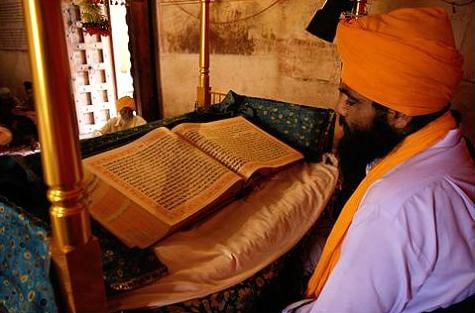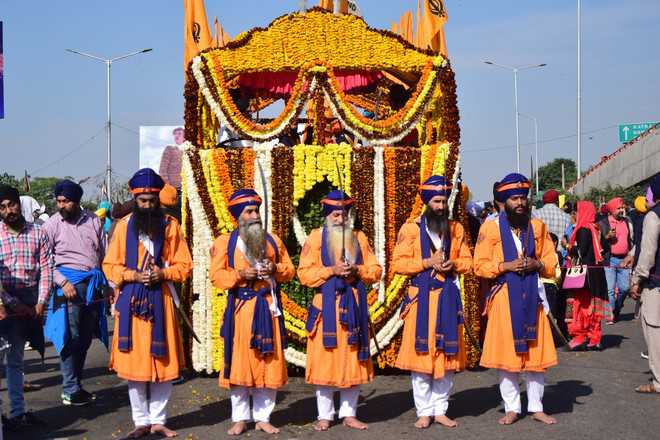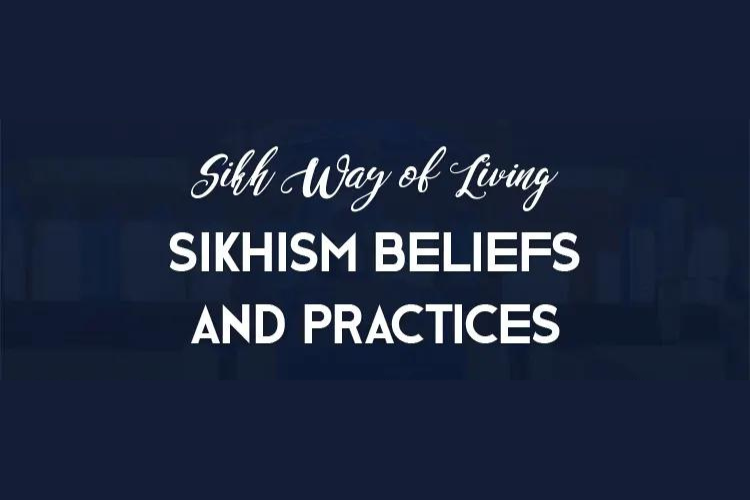What are the common Sikhism Beliefs and Practices? Sikhism is one of the world’s newest religions. It was founded by the Guru Nanak born in 1469. He emphasized inner spiritual awakening over outer religious forms, directing followers to rise early, bathe, meditate on the diving name and direct each day’s activities to God. Sikhism emphasized monotheism and rejected idol worship and the caste system.
Sikhs follow the teachings of 10 Gurus including the present embodiment of 10 Gurus and 25 other spiritually awakened Mahapurakhs known as Sri Guru Granth Sahib Ji. The Bani of Guru Granth Sahib is spiritual wisdom.
Sikhism is an international religion purely based on the doctrine of Guru Granth Sahib – the present Guru. In order for a person to be a Sikh in this religion, it is necessary for him to be aware of the three aspects of this religion.
Who is Sikh?
A learner, student, and knowledge seeker.
The word ‘Sikh’ is often interpreted to mean a disciple (from Sanskrit, Shishya), but in actual fact, it derives its origin from Pali and means the same as in the great Buddha’s Dhammpad” the elect, or in Sikh parlance, chosen (by God), God’s own. The nomenclature of ‘Khalsa’ which Guru Gobind Singh gave to the brotherhood of the Sikhs also means the same, being derived from the Persian term then current for King’s own (lands). Viewed thus, the true purpose of founding the Sikh order is not merely as a system of religion but also as a’ distinct, because all-embracing, the social organism becomes manifest.
What is Sikhism?
It is life according to the Gurmat. It is a positive, spiritually oriented, and life-affirming philosophy as manifested through the divine sermons inscribed in the holy Guru Granth Sahib Ji.
Sikhism originated with Guru Nanak about five hundred years back in the northwest of the Indian sub-continent. Thus, chronologically, it belongs to the medieval period in Indian history but an in-depth study of the Sikhism beliefs and practices reveals its critical attitude towards the medieval spirit and its responsiveness to modernity. It is also the youngest of major world religions and being the youngest, it can also be called the latest stage in the evolution of the religious consciousness of mankind. It originated in India but has since spread throughout the world despite the fact that it is not a missionary faith. No doubt, the Sikh expansion is mainly because of the Sikh Diaspora, but the dissemination of knowledge about the faith has also helped in this expansion, though in a limited way. If the Sikhs today are able to adjust and adapt to alien cultural and religious situations, it is because their faith has answers to many questions and queries posed by modernity.
Sikh Doctrine
Sikh gets it through Shabad Guru Gurbani (Every Sikh has to get this Shabad Guru Gurbani) Gyan / Vichar himself. Read this Shabad Guru Gurbani Gyan / Vichar himself, If you can’t read then you have to listen, believe, think, and bring it into the practice of your human life.)
Holy Scripture
The holy scripture of the Sikhs is called Sri Guru Granth Sahib Ji, which is all in verse and in praise of God. Its key message is related to the realities of life and our existence in this world. Every morning Granthi Singh opens up the Scripture known as Parkash of Guru Sahib, and the very first lines he read are known as Hukamnama Sahib. Hukamnama is a sort of order by the Guru to all his disciples, they should understand it and live their lives according to it. Another Hukamnama is taken in the evening, known as Sandhya Vele Da Hukamnama, after that Singh Sahib put Guru Granth Sahib to rest known as ‘Sukh-Asana’.

Basic Sikhism Beliefs
One of the basic Sikhism Beliefs is, that there is only one God, the Truth, The Creator, the Timeless Being, not incarnate, but self-existent. The popular Sikh word for God is Waheguru (wonderful Lord). If you ever ask a Sikh about Sikhism Beliefs, most probably he will tell you – ‘Naam Japo, Kirat Karo, and Vand Chhko’ which means ‘Always remember almighty, Earn your bread and share with others.’
The Sikh Articles of Faith: 5Ks
The Sikh Articles of Faith are popularly known as the 5K’s, namely
- Kesh (uncut hair),
- Kangha (comb),
- Karra (steel bangle),
- Kachhehra (special pair of shorts), and
- Kirpan (sword),

which are symbolic of Sikh identity and Sikhism beliefs. It is imperative for an Amritdhari Sikh to wear these 5K’s, which stand for humility, cleanliness, restraint, continence, and dignity, respectively.
The Sikh Identity is generally associated with well-kept hair, beard, and turban. However, due to some adverse influences, not all male Sikhs are seen wearing turbans. Sikh women use a long scarf or a dupatta as a headcover.
The Sikh turban is the most respected part of a Sikh attire. It is fairly distinct and easily recognizable for its snugness and shape. It can be of any color, blue, black, white, red, orange, etc. Sikh women may or may not wear turban.
Homeland of the Sikhs
Panjab, India is the homeland of the Sikhs. There are about 20 million Sikhs in the world. At least 12 million live in Panjab, the rest in other parts of India and abroad e.g. U.K., U.S.A., Canada, Europe, Australia, Malaysia, Singapore, etc.
The Heritage Language of the Sikhs is Panjabi. It is written in the original indigenous script, later named Gurmukhi, which indeed is derived from the old Indian script called Sharada.
Common Traits
The Sikh Community in general constitutes very energetic and enduring people, who are also well known in India for their outstanding contribution to farming, sports, and military services. Hospitality, as well as chivalry, remains an integral part of their social life.
In the words of Sir Alexander Burnes:
“The Sikh nation is very large-hearted. In spite of racial differences, they co-exist with others happily and remain kind-hearted.”
A Sikh place of worship
A Sikh place of worship is called a Gurdwara. A Gurdwara is open to all visitors, whether Sikhs or non-Sikhs, as long as one is not under the influence of a drug, tobacco, or alcohol. Tea and warm vegetarian meals, called Langar, are readily available to everybody.
The holiest Sikh place in the world is Sri Harmander Sahib, popularly known as the Golden Temple. It is situated in the holy city of Amritsar, which is in Panjab, India.
Visiting a Gurudwara
Usually, a Gurdwara is open all day to the public, including any non-Sikh visitors. However, one is expected to observe the following etiquette before entering the prayer hall or the Langar hall (eatery).
One must appropriately cover his/her head; a scarf or a large handkerchief is regarded as preferable to a hat or a cap for a non-turbaned visitor. Most Gurdwaras have a free supply of suitable scarves, which may be borrowed during the visit. Visitors must take off their shoes and place them on the racks or space provided at the entrance.

Under no circumstances should a visitor be in possession of any tobacco product, alcoholic drink, or drug, nor should he/she have consumed any, or be under its influence, at the time of the visit.
On entering the prayer hall, it is obligatory for every Sikh, young and old, to show the utmost respect to the holy book, Guru Granth Sahib Ji. Sikhs usually bow down on their knees, often touching the floor with their foreheads. (However, a non-Sikh visitor may do so by a simple bowing gesture, or standing still for a second and then moving away with a respectful nod).
It is regarded as discourteous to sit or stand with one’s back to the Guru Granth, or to stretch one’s feet towards the holy Granth while sitting. Similarly, clapping is not allowed in the congregation hall.
The Sikh Greetings
Waheguru Ji Ka Khalsa,
Waheguru Ji Ki Fateh!
(Literally, the Khalsa belongs to God, and the victory belongs to God). The ‘Fateh’ is a salutation gifted by 10th master Guru Gobind Singh himself.
Sat Sri Akal
Literally, Truth is God or God is Truth. Having an implied message to remember God, remember Truth whatever the time state or circumstances.
Gurpurab Celebration & Nagar Keertan
A Sikh festival or holy day is called Gurpurab. It is a ‘Remembrance Day’ celebrated in honor of the Guru. The occasion reminds and inspires Sikhs of the Guru’s teachings and good deeds. Among Sikhs, a Gurpurb generates a lot of religious fervor and enthusiasm. It produces a feeling of joy and happiness, fellowship and devotion.
One of the ways, Sikhs like to celebrate a Gurpurb, is by sharing their joy and excitement in the open, with the wider community, in the form of a hymn singing procession or carnival through the major streets of the town. In Popular Sikhism Beliefs, this is called Nagar Keertan. (By the way, this provides a good opportunity to let all communities know who are the Sikhs?).

The Nagar Keertan requires a lot of planning and discipline, as well as, the cooperation of the local police. In general, it involves hundreds and thousands of Sikh men, women, and children, who are walking, reciting holy hymns, and enjoying the festive occasion.
The procession is led by Guru Granth Sahib Ji, seated in a Palki (a kind of decorated throne) on a purpose-built float. It is escorted by a body of troopers constituting 5 specially dressed ‘beloved Sikhs’ called Panj Piaray.
The whole long procession is dotted with a number of other activities. The variety of activities depends upon the strength and commitment of the Sikh community in the area. In general, these activities include hymn singing, playing drums, and displaying the Sikh martial art, Gatka.
All along the route of this slow-moving procession, a variety of refreshments are made available freely by volunteers to the walking congregants, as well as the street onlookers, irrespective of their faith or faculty.




